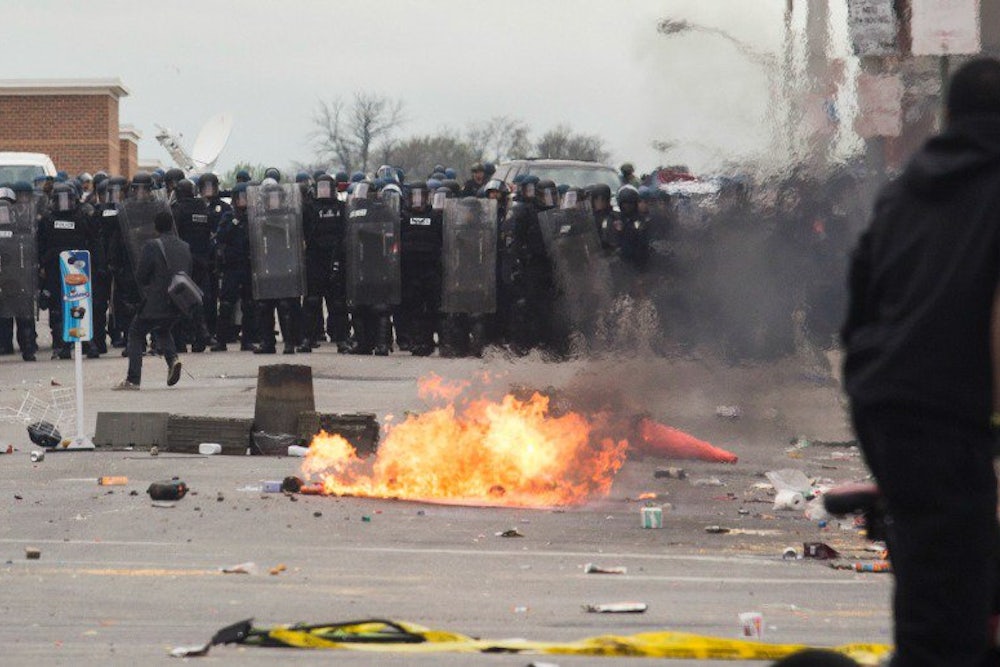A recent NBC/WSJ poll, conducted during the first three days of Baltimore's curfew last month, found that 96 percent of Americans believe racially charged unrest will continue this summer. Is there any reason to think they are right?
Studies have long noted the correlation between hot weather and violence, but there are social, political, and economic factors, too—it's just not easy for social scientists to know when those factors will create a combustible mix.
“Social scientists are much better at predicting the past than at predicting the future,” Seymour Spilerman, a professor in the sociology department at Columbia University, told me.
Despite the difficulty of forecasting riots, research has shown that there are certain characteristics and conditions that provide fertile ground for the precipitating events that often lead to riots.
In 1971, Spilerman published research on hundreds of race riots from the previous decade. “In the 1960s, there was only one predictor of where riots would occur and that was the numerical size of the black population,” he said. “No city characteristics made a difference—the unemployment rate of blacks vs. whites, whether the political structure was responsive to blacks, income differences—nothing made a difference.”
Economists have come up with similar findings. A 1996 study in the Journal of Urban Economics found that “ethnic diversity seems a significant determinant of rioting” in the 1960s, though non-white unemployment also correlated. The study supported the typical view of economists that connects the incidence of rioting with individuals’ cost-benefit analysis of participating. “Rioting is less common when the time or property costs of rioting are high,” the authors wrote.
The Kerner Commission, the 1968 government report which sought to explain the 1967 race riots, found police actions had contributed to “a reservoir of underlying grievances.” Many social scientists still hold this view. "Most riots are sparked by an incidence of police violence and usually the killing of an unarmed youth,” said Cathy Schneider of American University. "Police violence is the key." She said a lack of recourse creates widespread frustration. If complaints against police go unaddressed, “It’s only a matter of time before it’s explosive.” While many recognize police violence as a trigger, Schneider believes it’s been underestimated as an underlying cause.
Max Herman, a sociologist at New Jersey City University who has studied urban unrest, thinks that a “series of incidents involving police”—emphasizing the “series”—is necessary for urban unrest, adding that economic conditions and intense segregation are also important ingredients. The economic downturn following the 2008 financial crash added to African Americans' grievances. “Recession hammered hard at the black community,” Herman said.
The most promising method of “predicting” unrest might be through social media. Dan Braha, a professor at the University of Massachusetts and affiliate of the New England Complex Systems Institute, has studied unrest in hundreds of countries and the phenomenon of “contagion,” or how it spreads. In the past, printed newspapers, televisions, and other media played an important role, he said. “Today, the use of Twitter, Facebook, and other social media platforms is fundamental to the rapid self-organization and spreading of unrest activities—much like the spread of fire in a forest.” And the data from these media can be tracked. Riots, he claims, are certainly foreseeable, but “prediction regarding ‘when’ and ‘where’ becomes more precise on short time scales.”
The 96 percent of Americans who expect more unrest this summer may simply see a pattern emerging after events in Ferguson and Baltimore. Herman believes that this could be the reemergence of a “protest ideology” that hasn’t been seen since the ’60s. “It’s very clear from studying history that these things tend to run in cycles,” he said. “I think we are at the cusp of another cycle.”
